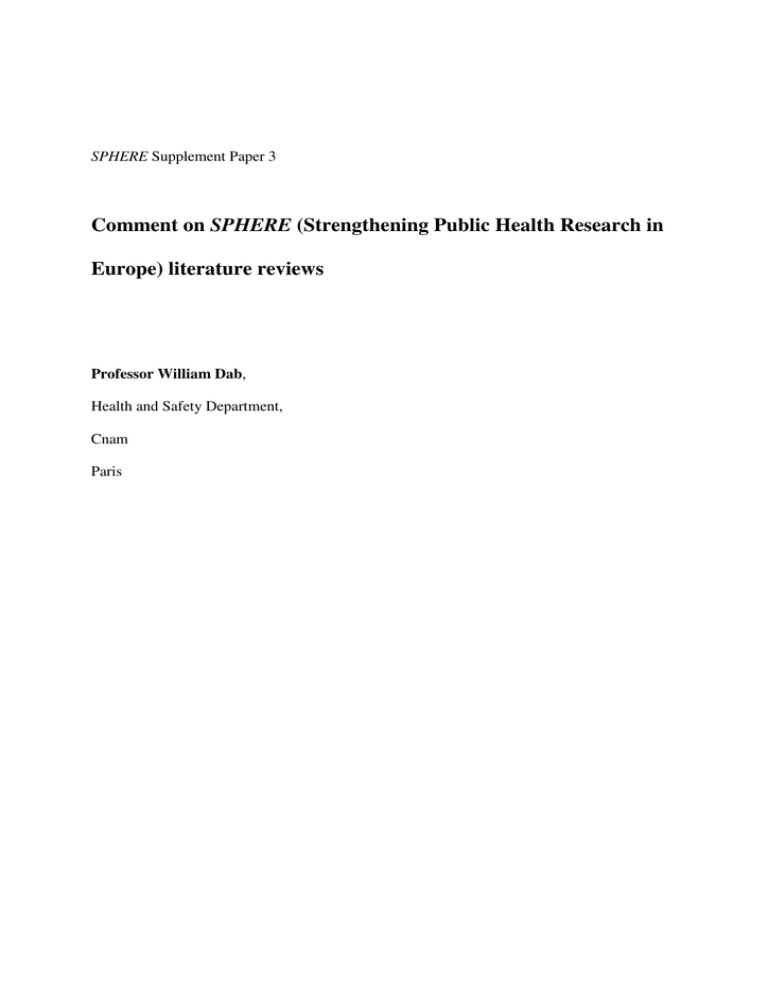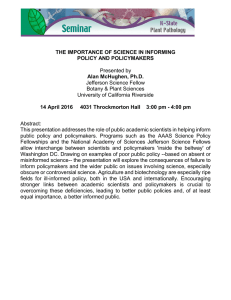SPHERE Europe) literature reviews Supplement Paper 3
advertisement

SPHERE Supplement Paper 3 Comment on SPHERE (Strengthening Public Health Research in Europe) literature reviews Professor William Dab, Health and Safety Department, Cnam Paris The work presented here is very instructive for public health professionals, researchers and decision makers. It’s a kind of meta-research that provides data regarding the vitality of this field in Europe. More than 200,000 articles have been identified in this project. That gives an idea of the importance of the efforts devoted to the public health research. It is encouraging to note that this scientific production has been increasing during the last decade and, overall, Europe should not be ashamed of its accomplishment. In the same time, this work raises the issues facing public health policymakers when they wish to promote an evidence-based approach. How to identify true knowledge in this huge amount of data? How to organize the systematic surveillance and synthesis of these results and to disseminate it in a timely way to the relevant policymakers? These are the main general questions rising from this report. I have a few methodological remarks even if bibliometrics is not my own field of research. Potentially, all biological, sociological, economical, epidemiological, drug and law sciences could have been included in this analysis. Wisely, the authors have chosen a non-disciplinary approach, putting the population aspects as the main criteria for selecting the relevant articles. In particular, the inclusion of a chapter related to the public health management is especially useful. However the choice has also been made to analyse specifically the literature regarding genetic epidemiology. This field is notably an important one but so would have been the epidemiology of ageing, for instance. This choice is not really explained and is not fully coherent with the global approach of this work. As an international project, one can also regret that the analysis provides no data concerning articles that have been published with more than one country authorship. This could have reflected the intensity of the European network in the field of public health research. These points are more or less anecdotic. The core message of the report is the gap between the public health needs and research investments. This point deserves consideration. It is clear that countries with the worst health status tend also to have the least scientific production, although GNP and educational level are obviously confounding factors in this association. Yet, generally speaking, it must be admitted that science and public health decision are not driven by the same forces. The aim of the scientific work is to improve knowledge about the way the world is functioning. The aim of a public health policy is (or should be) to improve the health status of the population. The scientific community would not accept that the choices of the themes of research or the hypothesis or the methodology are governed by policy considerations. Furthermore, one can argue that when a public health need is recognized, this is a priority for action and not for research. In this sense the finding of a gap between the health needs and the scientific production is not totally a surprise. But in the same time, we all think that evidence-based policies are better than opinion based policies. So it is true that some link has to be organized between the scientific results and the public health actions. The entire question is how to achieve this link and the main contribution of this research is to explore that point. In the field of Public Health, we should recognize that part of this link between research and action has to be reversed. The usual sequence is: new knowledge allows or implies new actions. The reversed link would be: new actions are needed to improve the health of the population but there are uncertainties that constitute obstacles when conceiving decisions (particularly if this decision has a cost). These uncertainties should stimulate specific research in order to reduce uncertainty and facilitate the decision process. It is not just a discussion regarding fundamental or applied research. It is a question of organizing a “pipe line” between scientific production and public health actions. And the reality is that it only exists in very few countries inside Europe. So the main lesson of this work is to give a clear picture of the research activity in the field of public health and to provide a strong incentive to better organize the evaluation of the available data. Unfortunately, the reality is even more complex. First we should recall that the health field is not a full competency for the European Union. National policies are the most important. Is a knowledge product in one country is valid for another? Regarding the importance of the cultural factors in the field of Public Health, it is not obvious. The World Health Organisation Regional Office for Europe is pursuing a very interesting project on this topic named Health Evidence Network (HEN). And, second, in all countries, one should recognize that the Public Health agenda is not necessarily driven by scientific considerations, neither sometimes by the health needs. Considerations related to the visibility in the media sphere or economic interests or the influences of different lobbies are certainly much stronger factors determining the public health policies than purely scientific considerations. So we have a double question. i) Are researchers ready to admit that part of their work may be influenced by policy considerations? ii) Do the public health policymakers have a sufficient scientific background in order to have a fruitful dialogue with the scientific community, or do they just want to accept a scientific influence in their work? As we can see, the link between public health needs and the scientific process is not at all self-evident and just stating an “inverse research law” is a little bit naïve. This is why it is so important to promote the diffusion of the available scientific knowledge at a community level. Usually, each research team is not able to do that by itself. This reason is in itself sufficient to justify a second phase of this project. It is the duty of the scientific community to organise itself in order to better influence health policies. Finally, I would like to comment about the field of environmental health which is my actual topic of research. I have been struck by the rapid quantitative increase of the scientific production in this field, which is very encouraging. However, it is also striking to note that more than ninety per cent of this work is devoted to risk assessment, while risk management is almost not a subject of scientific work. In other words, scientists are mainly devoted to identifying the environmental causes or risk factors of the diseases (i.e. the “why?” question) but very few of them are involved in the “what to do and how to do it question?” The controversy on small particulate matter (PM2.5) is very instructive from this point of view. We are able to identify the hazards linked to exposure to this air pollutant, to quantify the risks and even to calculate the number of deaths that could be avoided if the level of the air pollutants is decreased. But in spite of this very clear scientific evidence, European policymakers have adopted threshold levels far above the scientific recommendations. Part of the explanation is economic. But part of it is also in the lack of knowledge regarding the way to manage this question efficiently. And it’s true that it is easier to say, “You should implement an annual mean standard of 15 µg/m3”, without saying enough about the tools available to reach such a goal, the efficiency of those tools, their social acceptability and of course their cost. I chair the European Environmental and Health Committee inside the WHO Euro Office, and I can see at each meeting the deficit of knowledge we have in the field of risk management. My final remark will be to link the last two points. If it is so difficult to build evidence based public health policies, maybe is it also because we have very little evidence related to the risk management process. I strongly encourage the research teams involved in this project to continue this work. If we want to reinforce the scientific component of public health policies, we must be able to provide a clear picture of its state. My recommendation would be to follow up this topic from a quantitative point of view but also to explore more qualitative aspects like the quality issues, the validity from a scientific and decisional position and also the ability to influence the decisional processes. Acknowledgements SPHERE (coordinator Professor Mark McCarthy) was funded by the European Commission Sixth Framework Research programme, during the period 2005-2007. This review comment was presented at the 14th Conference of the European Association for Public Health (EUPHA), Montreux, Switzerland, 16th November 2006.




